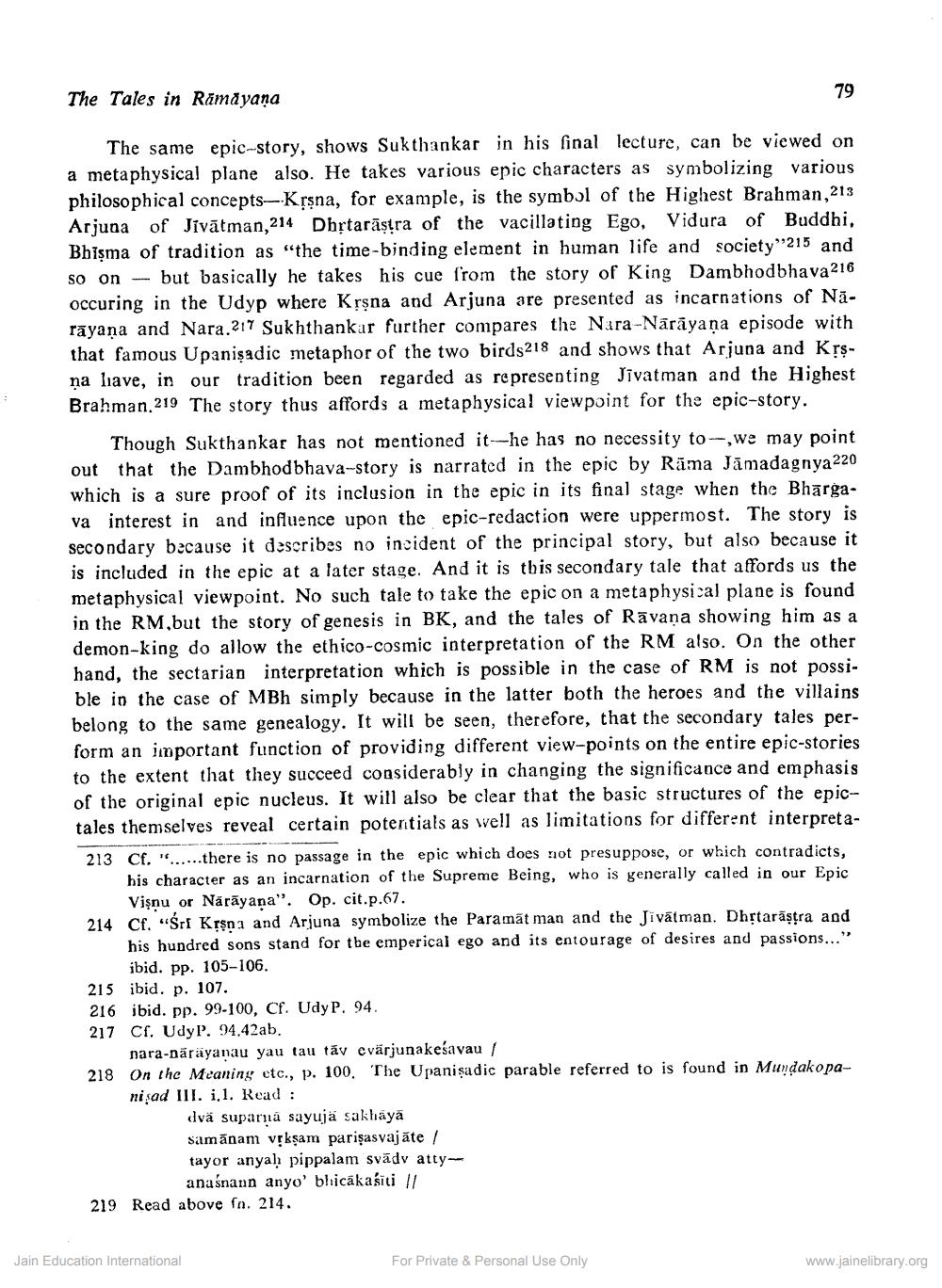________________
The Tales in Ramayana
79
The same epic-story, shows Sukthankar in his final lecture, can be viewed on a metaphysical plane also. He takes various epic characters as symbolizing various philosophical concepts-Krsna, for example, is the symbol of the Highest Brahman,213 Arjuna of Jivātman,214 Dhrtarāstra of the vacillating Ego, Vidura of Buddhi, Bhişma of tradition as "the time-binding element in human life and society”215 and so on - but basically he takes his cue from the story of King Dambhodbhava 216 occuring in the Udyp where Krşna and Arjuna are presented as incarnations of Nărāyaṇa and Nara.217 Sukhthankar further compares the Nara-Nārāyaṇa episode with that famous Upanişadic metaphor of the two birds218 and shows that Arjuna and Krsņa liave, in our tradition been regarded as representing Jivatman and the Highest Brahman.219 The story thus affords a metaphysical viewpoint for the epic-story.
Though Sukthankar has not mentioned it-he has no necessity to --, we may point out that the Dambhodbhava-story is narrated in the epic by Rāma Jāmadagnya 220 which is a sure proof of its inclusion in the epic in its final stage when the Bhargava interest in and influence upon the epic-redaction were uppermost. The story is secondary because it describes no incident of the principal story, but also because it is included in the epic at a later stage. And it is this secondary tale that affords us the metaphysical viewpoint. No such tale to take the epic on a metaphysical plane is found in the RM.but the story of genesis in BK, and the tales of Rāvana showing him as a demon-king do allow the ethico-cosmic interpretation of the RM also. On the other hand, the sectarian interpretation which is possible in the case of RM is not possible in the case of MBh simply because in the latter both the heroes and the villains belong to the same genealogy. It will be seen, therefore, that the secondary tales perform an important function of providing different view-points on the entire epic-stories to the extent that they succeed considerably in changing the significance and emphasis of the original epic nucleus. It will also be clear that the basic structures of the epic-- tales themselves reveal certain potentials as well as limitations for different interpreta213 Cf. "......there is no passage in the epic which does not presuppose, or which contradicts,
his character as an incarnation of the Supreme Being, who is generally called in our Epic
Vişnu or Nārāyana". Op. cit.p.67. 214 Cf. "Sri Krsna and Arjuna symbolize the Paramāt man and the Jivātman, Dhitarăstra and
his hundred sons stand for the emperical ego and its entourage of desires and passions..."
ibid. pp. 105-106. 215 ibid. p. 107. 216 ibid. pp. 99-100, Cf. Udy P. 94. 217 Cf. Udy P'. 94.42ab.
nara-narayanau yau tau tāv cvärjunakeśavau / 218 On the Meaning etc., p. 100. The Upanişadic parable referred to is found in Mundakopanişad Ill. i.1. Read :
dvä suparna sayuja sakhaya samānam vşkşam parişasvajate tayor anyah pippalam svādv atty
anaśnann anyo' bhicākasiti // 219 Read above fn. 214.
Jain Education International
For Private & Personal Use Only
www.jainelibrary.org




